Introduction: Teaching Children with Learning Disabilities
- The current tendencies in addressing the needs of children with disabilities adopted by the UAE teachers need further improvement (Myers, 2013);
- The lack of focus on the specific needs of learners with disabilities (LWD) calls for a redesign of the strategies used by teachers in the public school setting;
- Unfortunately, the lack of inclusion of LWD in the UAE schools does not allow for an in-depth analysis of the needs thereof and the identification of the appropriate strategies.
Creating the environment, in which all learners are provided with an opportunity to acquire essential knowledge and skills, is imperative in the context of the modern education. However, the current UAE public school environment does not allow for the provision of the necessary skills due to the lack of a proper teaching strategy.
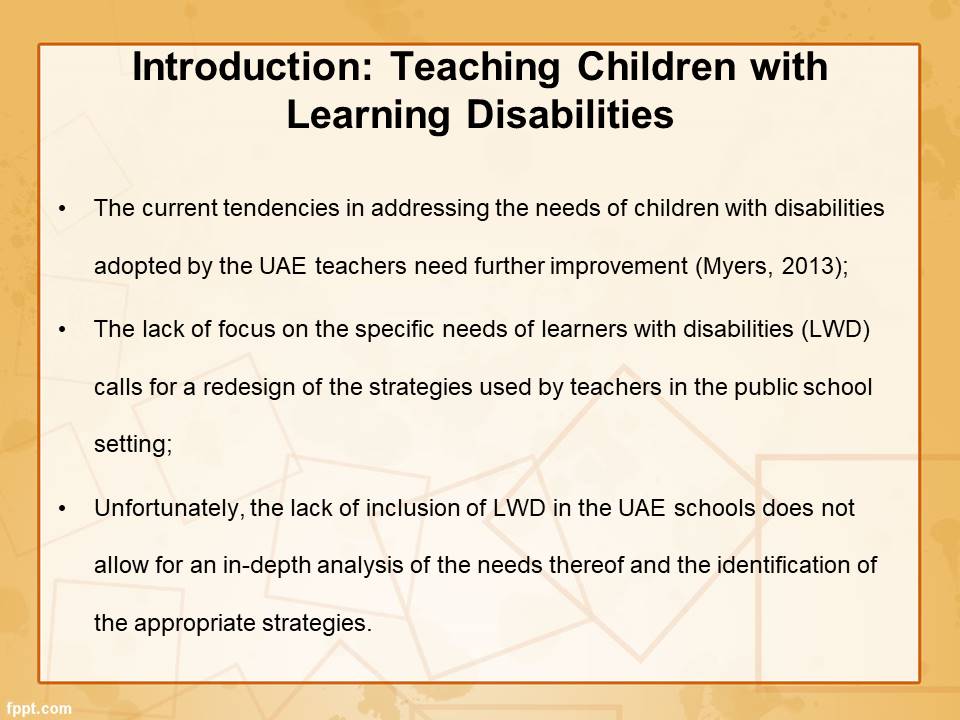
Problems in Teaching Children with Disabilities in the UAE
- A range of the UAE teachers, especially in public schools, have a variety of perceptions toward LWD due to the current inclusion policy;
- The perceptions range from positive to neutral to negative;
- No matter what emotional coloring the perceptions have, they affect the process of knowledge acquisition by learners in the most drastic manner, impeding it to a significant extent (Oslund, 2014);
- Therefore, the tools for changing the current attitudes toward LWD will have to be sought and used in the context of the UAE education.
At present, the inclusion policy is applied to the provision of education to LWD students. However, the lack of awareness of the LWD’s needs along with popular perceptions about them lead to teachers developing prejudice and, therefore, causing the learning process to stall.
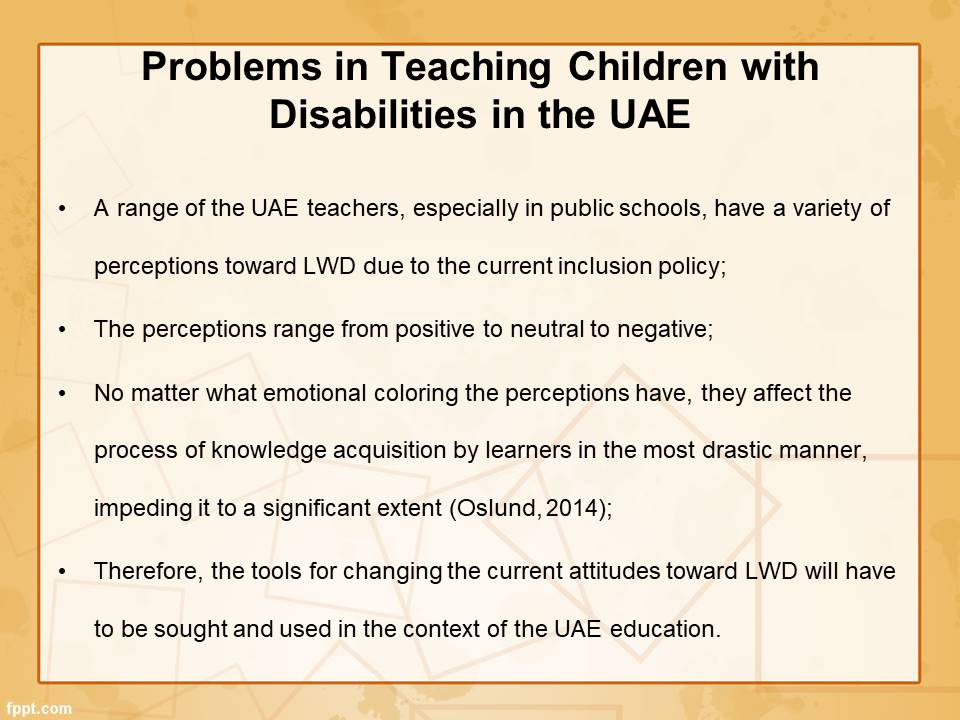
Goals: Shedding Light on the Current Issues
- Identifying the approaches that the UAE teachers can adopt to assess and meet the needs of LWD in the public school setting;
- Locating the strategies that will help promote a better connection between the teacher and the learner;
- Designing the tool that will help assess the learners’ needs accurately and be used to develop the method of meeting the above needs successfully;
- Offering the model that will contribute to raising awareness among the UAE teachers about the necessity to meet specific needs of LWD.
To acquire the necessary knowledge, LWD need unique approaches that the UAE teachers must design. It is essential that a device for measuring the progress made by LWD should be created as well. Thus, the progress will become traceable.
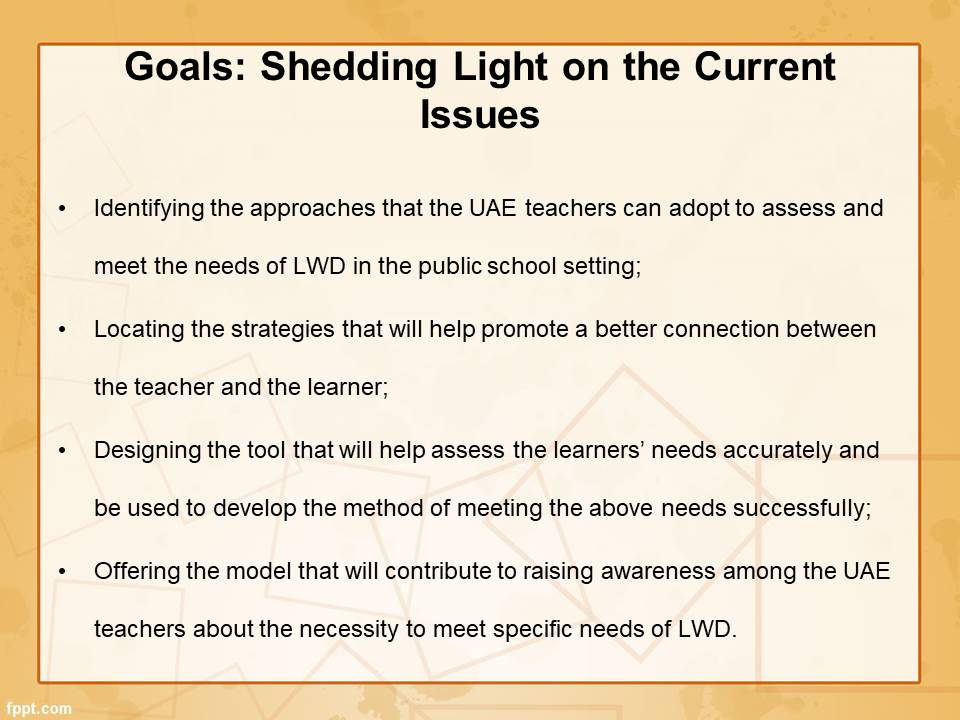
Teachers’ Attitudes to Inclusion: Analysis
- The UAE teachers split in their opinions on the inclusion policies and the sensibility thereof when it comes to considering the needs of LWD;
- The process of mainstream inclusion has been picking up the pace, yet the adequacy of the identified approach is yet to be evaluated;
- Teachers arguing against inclusion point to the fact that the classroom environment may become uncomfortable for the target learners;
- Teachers supporting inclusion assume that the integration into the society will help LWD succeed at making social contacts (Spears, 2014).
There has not yet been an agreement on the issue of inclusion. Although a range of the UAE instructors insist that the process of inclusion will cause deplorable effects for both LWD and the rest of the stakeholders (e.g., learners, teachers, etc.), others claim that socializing is a crucial step toward addressing the needs of LWD.
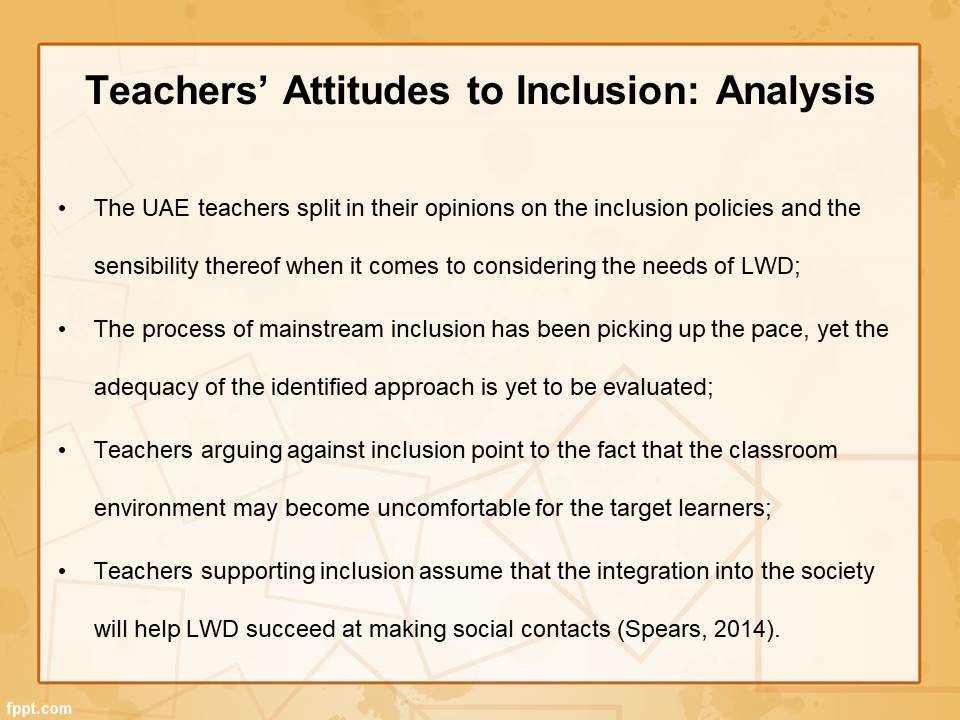
Tools for Data Collection and Their Benefits
- To gather the data, one had to consider the tools such as interviews and surveys;
- Semi-structured interviews allow for retrieving vast amounts of data that can be used for the further qualitative analysis;
- Surveys can be adopted to obtain the information that can be defined as quantitative and can be used further for determining the statistical information, e.g., the correlation between the successful and unsuccessful implementations of LWD-related policies, etc.
The study under analysis can be defined as mixed, since the data retrieved for the analysis includes both qualitative information and the one that will have to be quantitative. Particularly the use of interviews can be considered as such. The further analysis will help identify the relationships between the key variables.
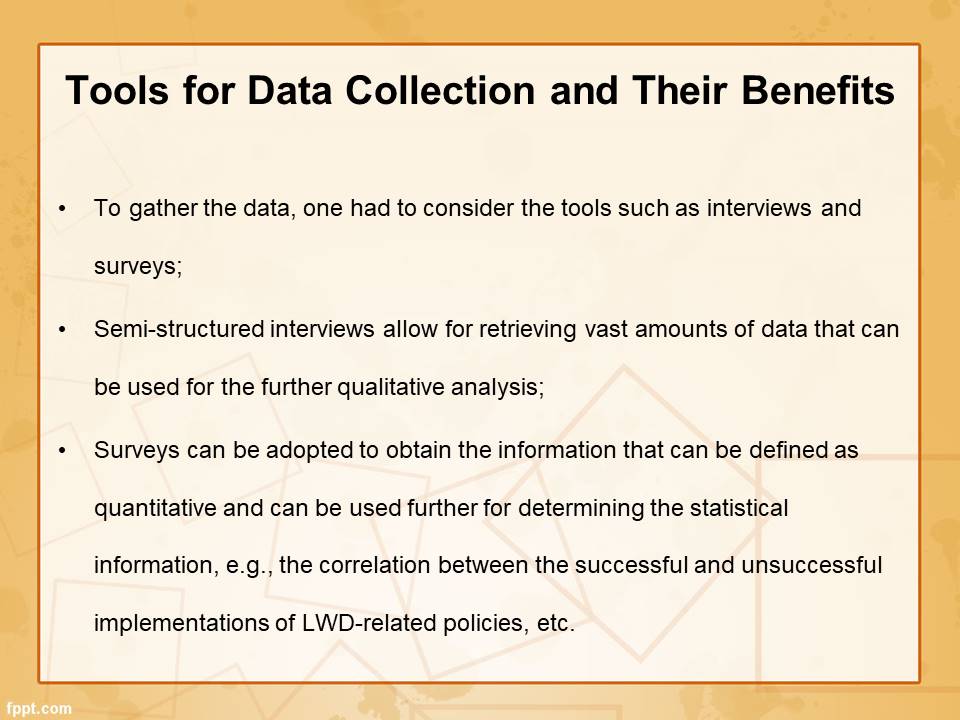
Benefits of Teacher’s Efficacy Scale: Significance
- Evaluating the performance of the UAE teachers is a primary step toward the analysis and a better understanding of the issue;
- The quality of the UAE teaching staff’s performance will be carried out with the help of the tool known as Bandura’s Teacher’s Efficacy Scale (BTES);
- BTES has been used widely to address the issue of self-efficacy in the educational setting;
- BTES uses the Likert scale as the primary tool for data collection and its further assessment (Bell & Aldridge, 2014).
It is crucial to introduce the tool that will allow for a detailed measurement of the UAE teachers’ performance. Currently, the Bandura’s Teacher’s Efficacy Scale (BTES) is viewed as one of the most successful methods. Therefore, its application should be viewed as the priority in the research.
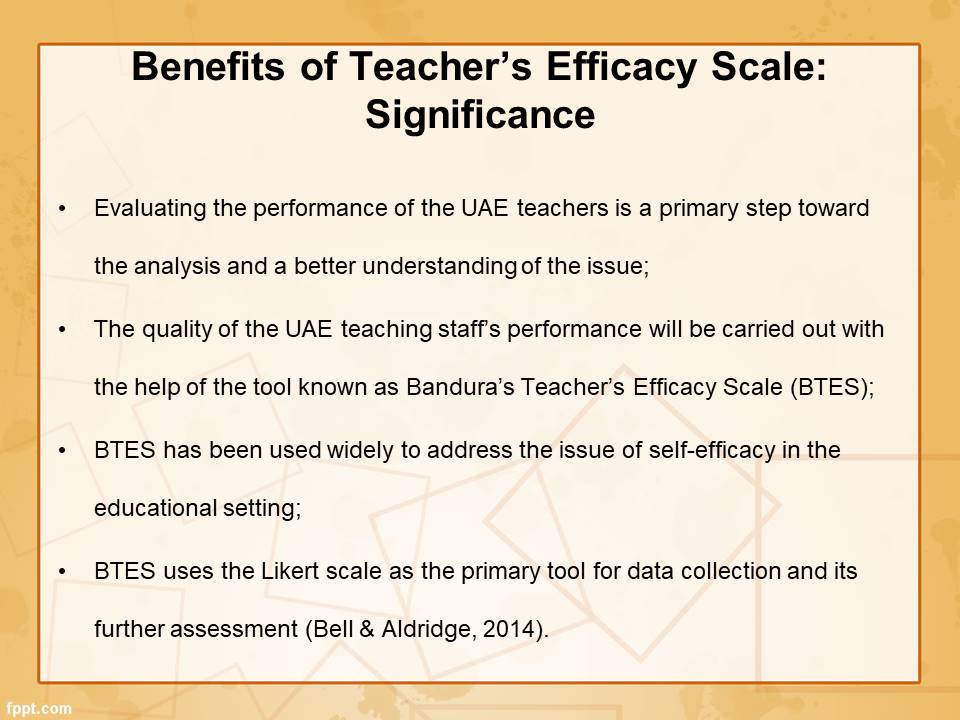
Teacher-Child Interaction in the Context of Child Development
- It is crucial that a positive link could be created between a teacher and a child so that the process of teaching and learning could run smoothly;
- Creating the above connection is complicated when aiming at teaching LWD because of the communication issues that the participants may have;
- Therefore, an elaborate approach must be adopted to teach the identified audience so that the teacher could communicate with every student;
- Non-instructional interaction is often viewed as a crucial part of a student-teacher communication for LWD (Keller & Mcnergney, 2013).
Unless strong relationships based in mutual trust and cooperation are created between a teacher and a student, a positive learning process is impossible. The communication among the participants in question becomes complicated once the needs of LWD have to be addressed. Thus, it is crucial that strong student-teacher ties should be built.
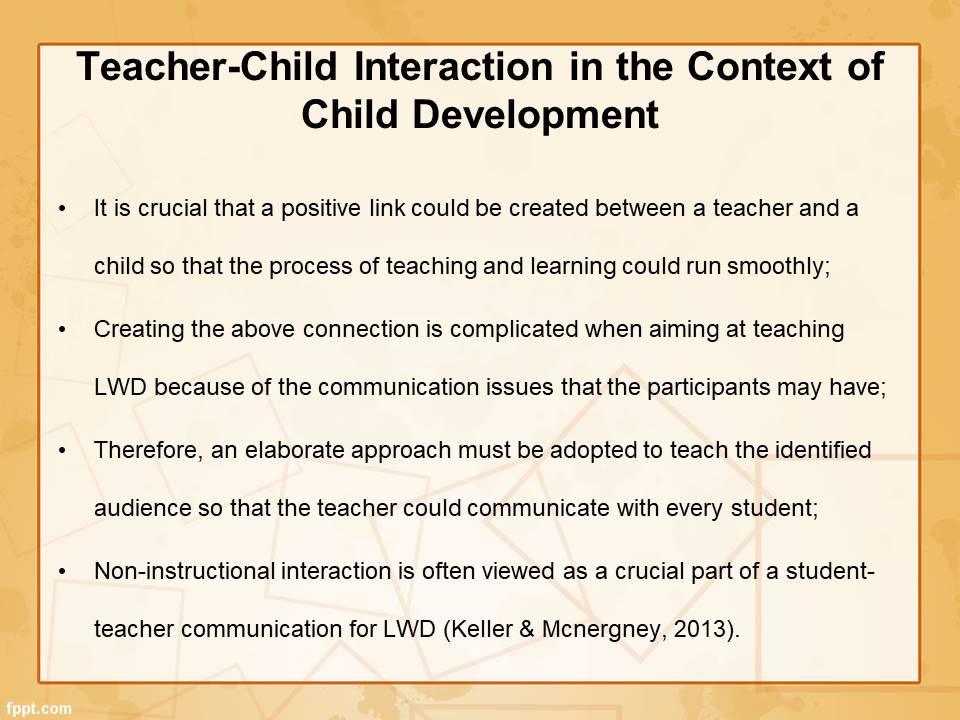
Curriculum and Children with Learning Disabilities: Problems Faced
- Adopting the strategies allowing for a more successful teaching process aimed at meeting the needs of LWD is hampered by outside factors;
- Poorly thought-out curriculum is one of those problems;
- The instructional strategies adopted currently are aimed at general audience and do not allow taking the needs of LWD into account;
- A redesign of the current instructional strategies is required to engage LWD in the classroom activities and allow them to participate actively in performing classroom tasks.
Because of the lack of awareness on the needs of LWD in the present-day UAE educational setting, teachers are incapable of creating the approach that will allow them to invite LWD to participate in the classroom activities, The task above, however, is crucial to the children’s development, particularly, the acquisition of social interaction patterns. Therefore, it is the teacher’s responsibility to come up with an integrative approach that will serve as the means of engaging lWD.
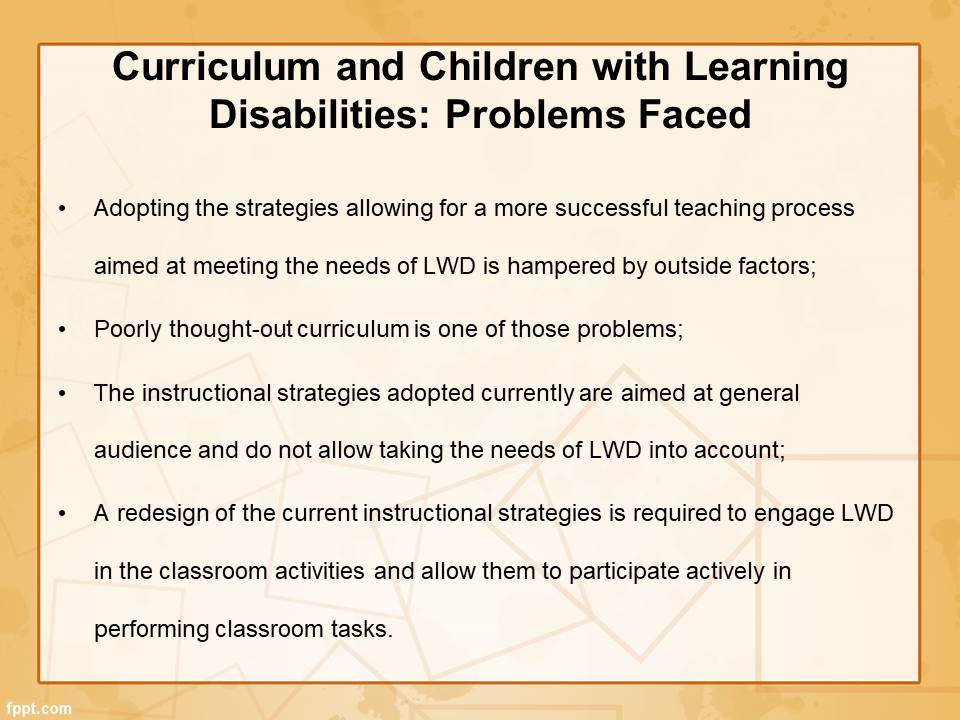
Trans-Disciplinary Model: Teaching Strategy
- The Trans-Disciplinary Model (TDM) can be viewed as the solution to the current problems in the UAE education;
- TDM serves as the means of informing the teacher about the strategies to adopt in the identified setting;
- TDM can be interpreted as the approach that allows learning to teach, i.e., helps both students and teachers acquire the necessary skills and build strong and trustworthy relationships with each other.
- TDM should be used as the primary means of meeting the needs of LWD.
Although the current approach toward addressing the needs of LWD used by the UAE teachers leaves much to be desired, the framework that can be adopted to improve the current state of affairs exists. Therefore, it is imperative that the subject matter should be integrated into the target environment.
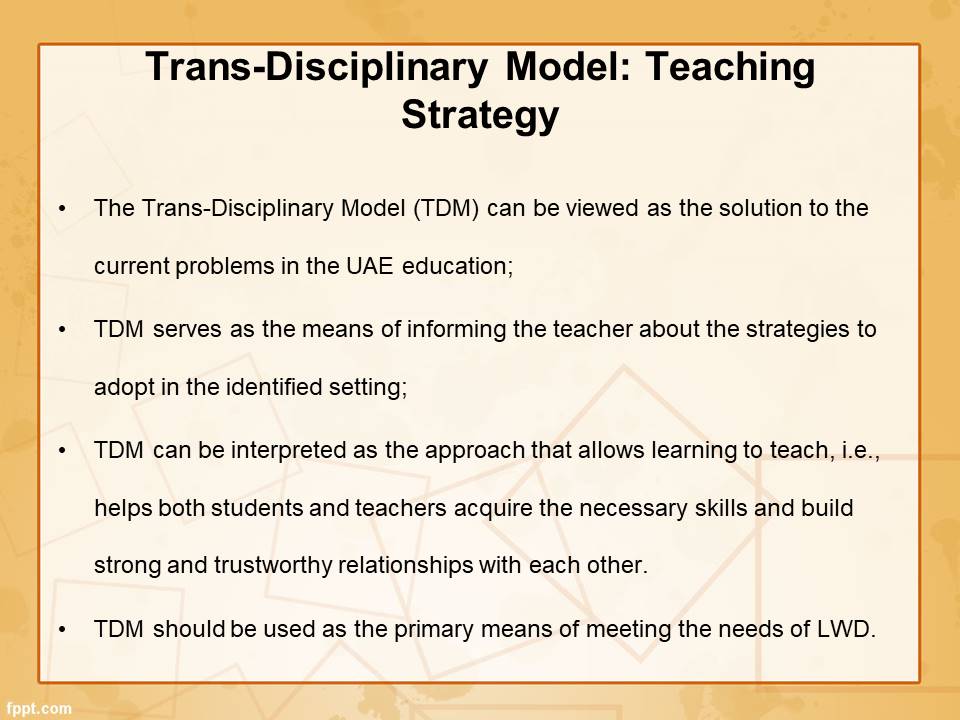
Multiple Education Principles in the UAE: Prospects and Opportunities
- Another approach to meeting the needs of LWD, the multiple education concept will have to be considered;
- Multiple education is typically rendered as the synonym of the multiple intelligence approach;
- The subject matter serves as the means of evaluating the learners’ abilities from several perspectives, therefore, identifying the areas that the students view as interesting and that they excel in;
- Thus, an elaborate teaching method can be designed to help LWD.
The theory of Multiple Intelligence is often viewed as a blessing in disguise because it allows for an identification of the areas that LWD can excel in. As a result, LWD can evolve and develop their skills based on their unique abilities. The MI theory, therefore, helps view LWD as unique personalities with specific interests and needs.
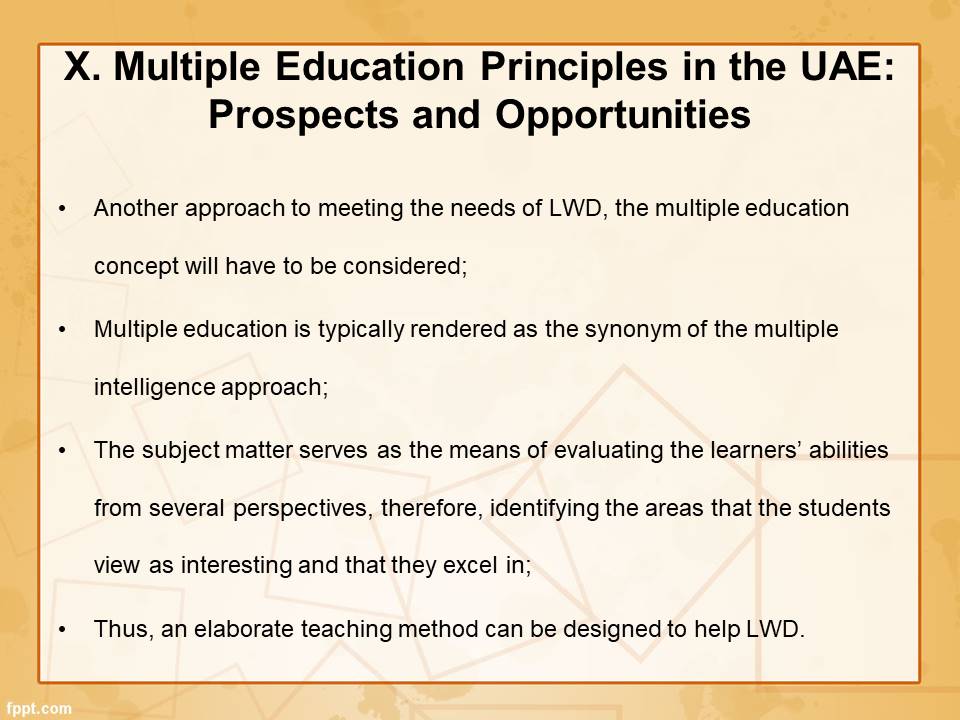
Inclusion: A General Overview. Problems and Benefits
- The strategy of inclusion allows LWD acquire the necessary communication skills and integrate successfully into the learning environment;
- However, LWD may face problems keeping up the pace with the rest of the students; as a result, LWD may feel dissatisfied;
- Therefore, the process of including LWD into the UAE educational environment will have to be carried out with great care and caution;
- It is essential to make sure that the rest of the students should not suffer from the changes as well.
The concept of inclusion is often taken with a grain of salt as LWD are typically viewed as the impediment that may take the rest of the students back in their learning process. The specified assumption, however, is entirely false. LWD are perfectly capable of carrying out certain academic tasks and may have outstanding abilities in certain areas.
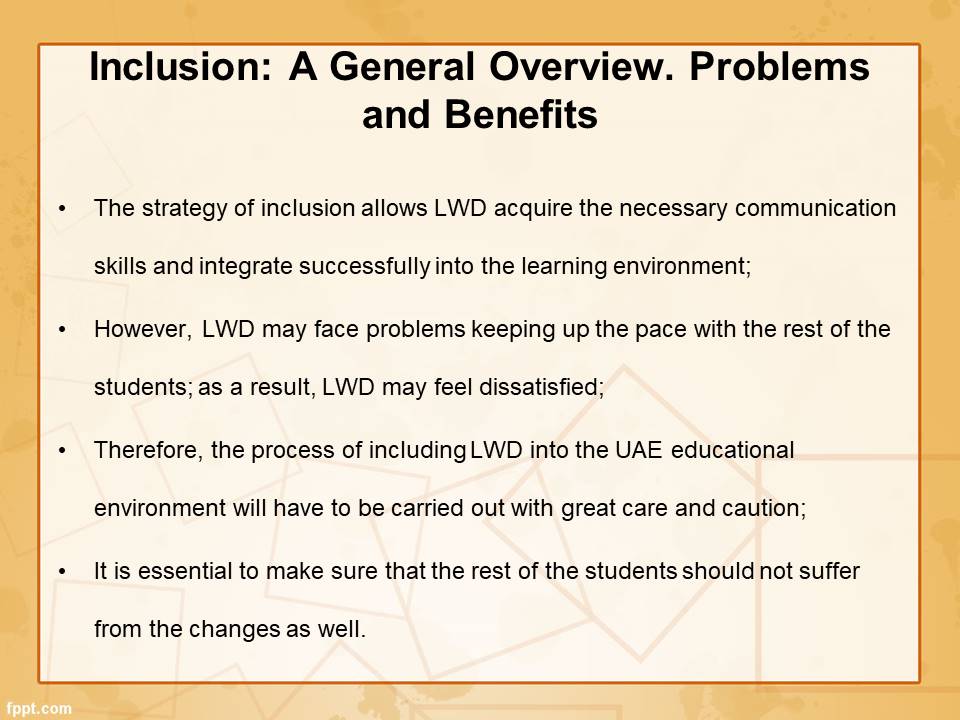
Inclusion in the UAE: Problems and Benefits
- The environment of the UAE creates the unique setting, thus, dictating specific rules for adopting the LWD-specific strategies;
- the necessity to engage parents into the process makes the process even more complicated;
- The current public image of inclusion leaves much to be desired and needs to be improved so that the concept should seem appealing to public;
- Overcoming social and cultural barriers may become a possibility once the principles of compromise-based negotiation are adopted (Boaventura, 2014).
Unfortunately, a range of people bear prejudice against the idea of including LWD in the setting of public schools. The reasons for the unwillingness may differ; however, in most cases, parents of the rest of the students are concerned with the wellbeing of their children, the parents of LWD are uncertain about the success of the learning process, and the teachers realize that, by choosing a wrong strategy, they will jeopardize the learning process.
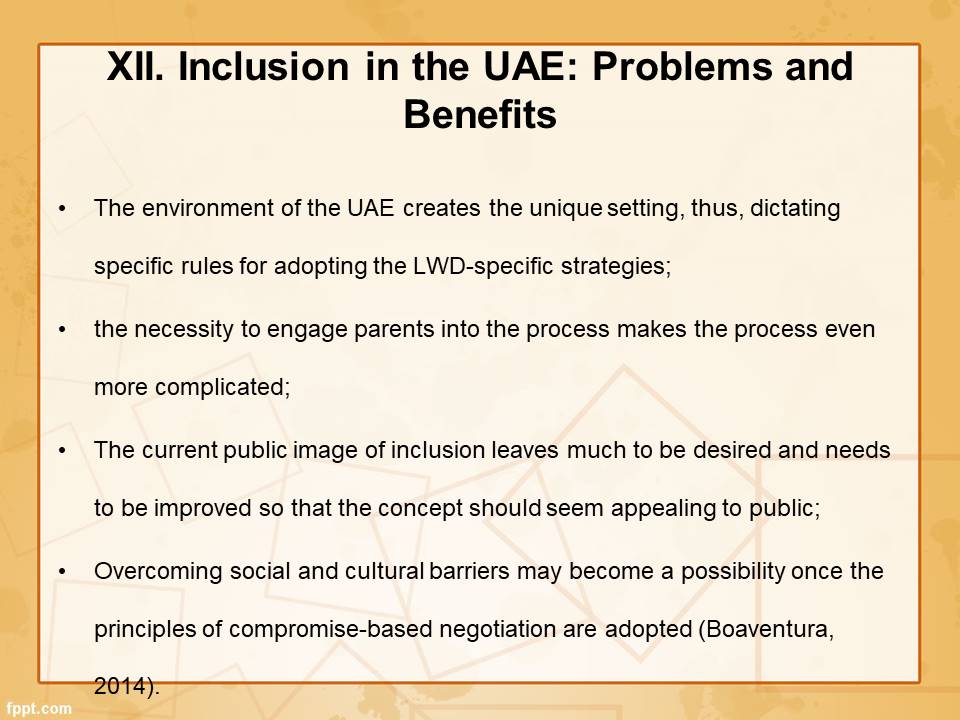
Means of Addressing the Current Issues: Analysis
- The adoption of the Multiple Intelligence approach is imperative to the success of the overall academic success of the students, including LWD and ordinary learners;
- Inclusion must be viewed as an essential change to the current learning environment design so that all students could feel comfortable in the academic environment;
- Therefore, it is crucial that awareness should be raised among the UAE teachers with the help of the Trans-Disciplinary Model.
The promotion of the approaches based on the Trans-Disciplinary Model is crucial to make sure that the UAE teachers should be able to teach LWD.
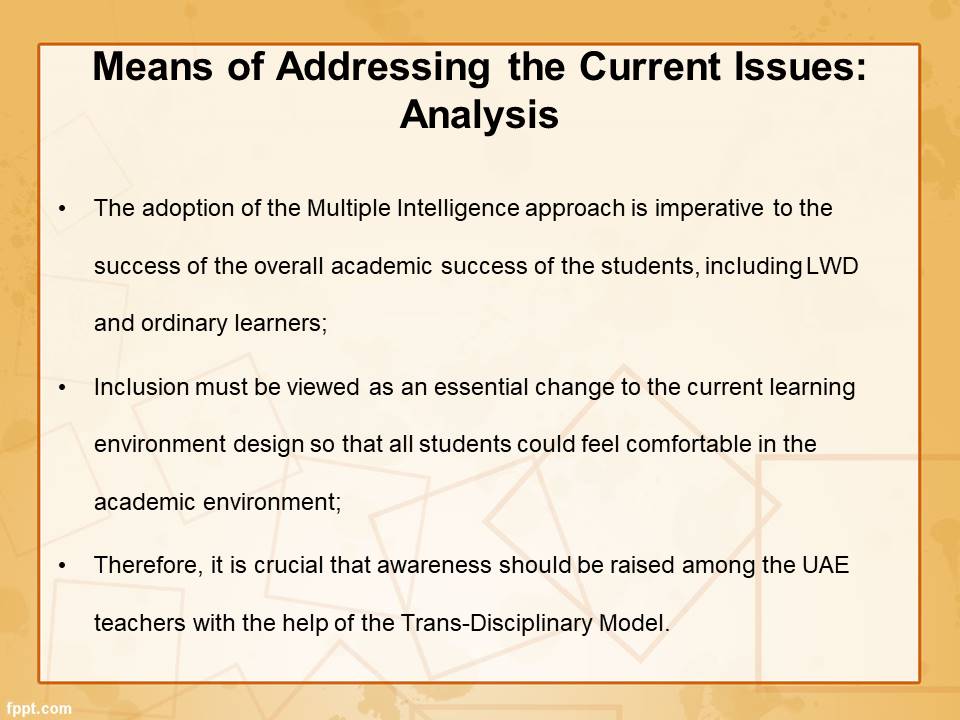
Summary and Conclusions
- Creating the learning environment that allows for teaching LWD is very complicated in the UAE environment due to the lack of awareness about the subject matter;
- A redesign of the approach for addressing the needs of LWD is a necessity;
- The promotion of the MI approach must be viewed as the key means of improving the teachers’ understanding of the needs and capacities of LWD;
- Teachers must engage LWD in classroom activities to help them develop social skills.
An overview of the current issues related to the LWD teaching and learning processes has shown that there is a consistent need in creating the environment that will help the target audience acquire the corresponding skills and knowledge in a fast and efficient manner. At the same time, the rest of the students should not experience difficulties that the shift toward an LWD-related approach may trigger. Therefore, it is advisable that the teachers should focus on the compliance with the MI philosophy.
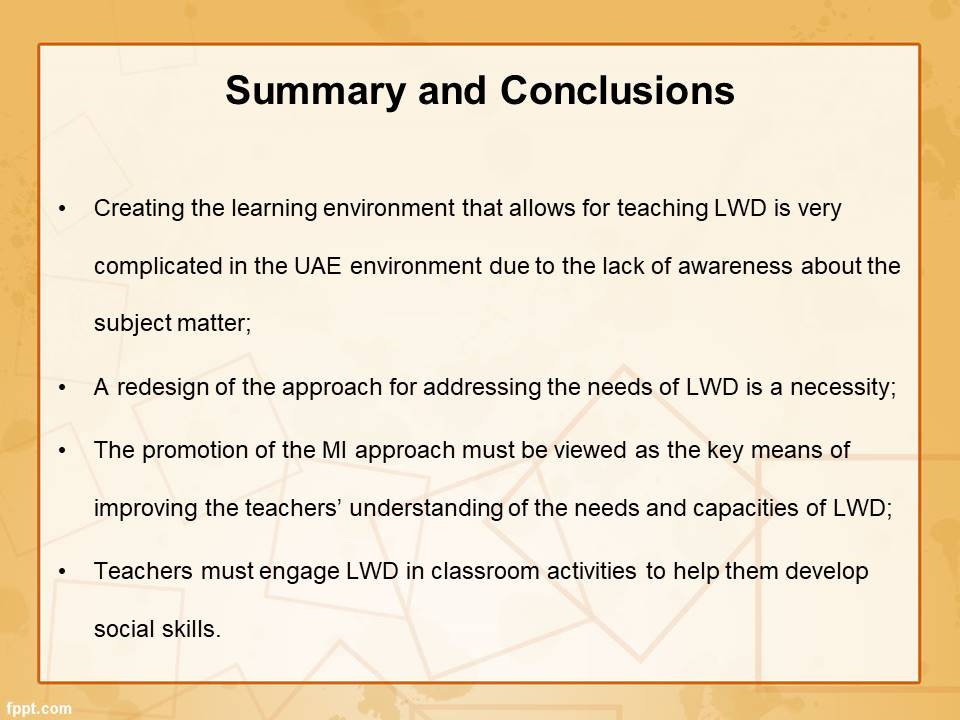
Reference List
Bell, L., & Aldridge, J. M. (2014). Student voice, teacher action research and classroom improvement. New York, NY: Springer.
Boaventura, D. (2014). Assistive technology research, practice, and theory. New York, NY: IGI Global.
Keller, C., & Mcnergney, R. (2013). Images of mainstreaming: Educating students with disabilities. New York, NY: Routledge.
Myers, N. H. (2013). Social skills deficits in students with disabilities: Successful strategies from the disabilities field. New York, NY: R&L Education.
Oslund, C. (2014). Disability services and disability studies in higher education: History, contexts, and social impacts. New York, NY: Springer.
Spears, V. (2014). How to teach FAS/FAE children. New York, NY: Lulu.com.